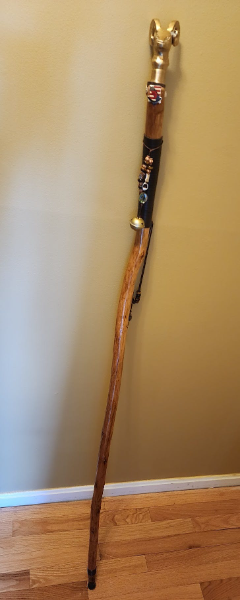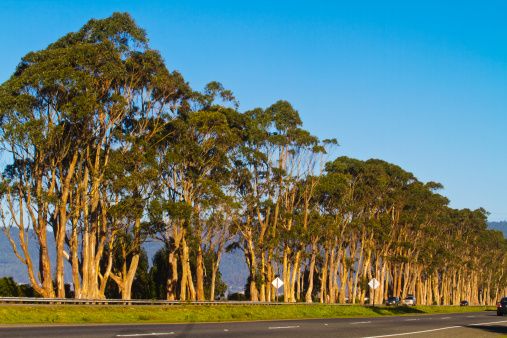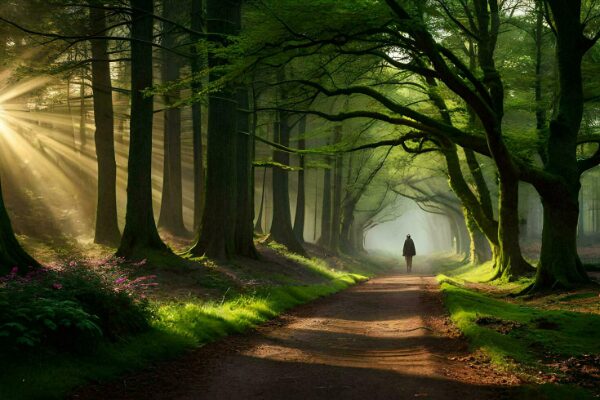Šumawka means “the tall one,”
a name drawn from the Chumash language to honor both
the height of the tree it came from—
and the enduring spirit of the land where it was found.

This staff’s journey began in 1972,
when a young man of 17 camped near Vandenberg Air Force Base,
just outside Lompoc, California.
There, he discovered a striking branch on the ground
in the coastal hills and windswept eucalyptus groves of his youth—
weathered,
twisted,
and tall.
He stripped off the bark,
fire-hardened the tip in campfire coals,
and honed it with the sandy soil beneath him.
What began as a hiking staff became a lifelong companion.
Fifty years later, it was reborn as Šumawka—
a preserved symbol of strength, silence, and the sacred path.
The Chumash People — The Name Givers
Long before missiles launched from Vandenberg
and highways carved through California’s coast,
the Chumash people thrived in these lands.
Their territory stretched from the beaches of Malibu
to the inland valleys of San Luis Obispo,
including what is now Santa Barbara and Lompoc.
Known for their artistry,
seafaring canoes,
and sophisticated trade networks,
the Chumash lived in deep connection with the land and sea.
Their language, once spoken in several dialects,
is being revitalized today—
an echo of resilience rising once more.
The name Šumawka draws from the Chumash root word šumaw, meaning “tree.”
The suffix -ka adds emphasis, evoking height, stature, or reverence.
Together, they speak of more than a plant—
they honor something rooted, rising, and revered.
Šumawka — Pronunciation in Syllables
SHOO-maw-kah
(3 syllables: SHOO – maw – kah)
Š = “sh” sound, like “shoe”
u = long “oo”
maw = like a lion’s maw
ka = soft “kah,” not sharp or guttural
So spoken aloud:
SHOO-maw-kah —
with a rhythmic, almost ceremonial cadence.
Kind of rolls off the tongue like something
carved into stone and whispered in the wind.
The Eucalyptus Tree — The One It Was Born From
Though native to Australia, eucalyptus trees were introduced to California in the 1850s.
By the early 20th century, they were planted in abundance—
especially near military bases and coastlines—
for windbreaks, erosion control, and railroad construction.
Along the coastal hills of Lompoc and Vandenberg,
eucalyptus groves became a distinct and towering feature of the landscape.
Their scent,
their shade,
their strange beauty—
are now woven into the memory of the land.
The Walk — A Life Carried Forward
Šumawka was never just carried.
It carried back.
It has felt alpine winds above timberline
and desert heat below sea level.
It has steadied knees through canyons
and stirred coals in campfires
where silence said more than words.
It has leaned against pines,
redwoods,
and fence posts—
never forgotten,
never ornamental.
In times of peace,
it was a walking staff.
In times of trial,
it was a spine.
A quiet sentinel
through decades of becoming.
My post to lean on—
and to know that it would always be there for…
“Me.”
Šumawka — The Staff That Props Me
Šumawka, then, is a union of worlds—
a native soul and an adopted form.
Fire-tested,
hand-forged,
and spirit-named.
It has walked the High Sierras.
It has stood in silent defiance.
It now bears the weight of legacy.
My spirit walks with “Šumawka”—
a 6’ staff and a 6’5” 71-year “Pathfinder.”
The tall trees of life still stand.
Suggested song for reflection:
🎵 “Into the Mystic” – Van Morrison
Tags preserved:
#Šumawka #TheTallOne #SacredStaff #ChumashWisdom #LegacyWalk
#SpiritualTools #SymbolOfStrength #FireForged #RootedAndRising
#WalkingWithPurpose #ElderWisdom #NativeSoulAdoptedForm






